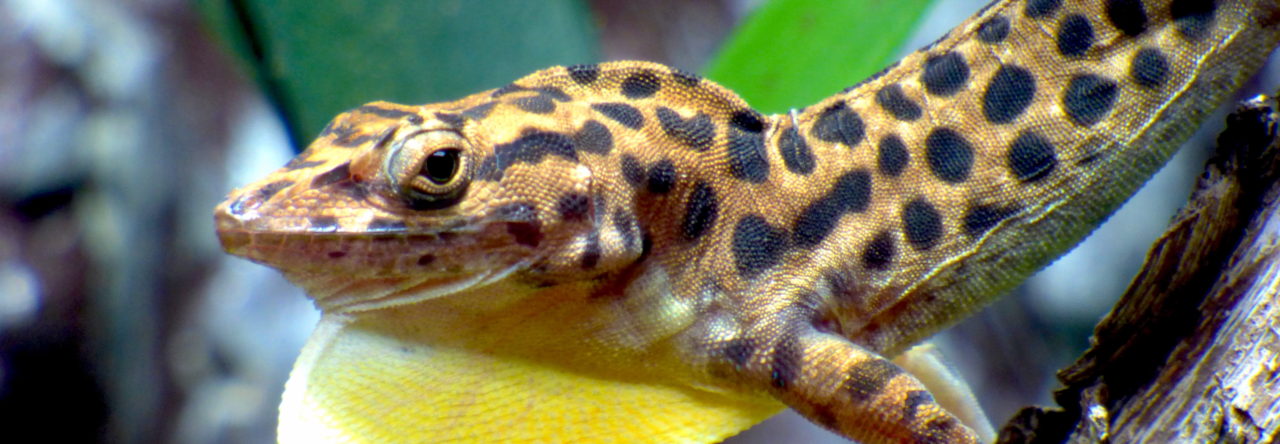Today’s post is only tangentially related to anoles, but it’s about a new paper that seems to have received relatively little attention, so I thought it worth writing about. The idea of founder effect speciation goes back to the writings of Ernst Mayr and historically has been very important in the development of ideas about how new species originate. However, in recent years FE speciation has fallen on hard times. Theorists have claimed it to be highly unlikely, lab experiments have failed to find much support for it. More than a few evolutionary biologists have declared the idea dead and buried.
As an aside, why talk about FE speciation in these pages? The answer is simple—at least a few anoles (e.g., the green anole, A. carolinensis, and the festive anole, A. sagrei) have routinely colonized islands in the Caribbean, and very likely many of these colonizations involve the arrival of a single, impregnated, female. If the FE speciation occurs, these Caribbean anoles might be a good place to look for it. Moreover, a recent experimental study on A. sagrei (of which I was an author) reported that founder effects could have persistent effects on morphology, at least over the several-year span of the study.
And that leads us to the study in question, by Daniel Matute of the University of Chicago (and soon to be faculty at the University of North Carolina). In a truly gargantuan experiment on laboratory fruitflies just published in the Journal of Evolutionary Biology, Matute showed that reproductive isolation can, in fact, evolve as a result of extreme and persistent founder effects. The extent of this study is truly mind-boggling. A founder effect was induced by taking a single male and female fruit fly and putting them in a vial. Then, from their eggs, a single male and female were randomly chosen to form the second generation. This was continued for 30 generations. Sounds like a lot of work, right? Well, catch this: Matute started this experiment with not a single vial containing two flies, but with 1000 vials in which he replicated the experiment–I’ve never heard of such a massive experiment (though some Drosophila-savvy friends say I need to read the literature more). Now, admittedly many of the populations went extinct very quickly because of the intense inbreeding—80% were gone by generation 5 and only 12% lasted the full 30 generations. But, still that’s a lot of Drosophila TLC.

Degree of reproductive isolation (as measured from mate choice trials). The red histogram is the distribution of reproductive isolation between founder effect populations and the parental population; blue is between individuals from parental populations. Approximately 100 out of 123 surviving founder effect populations had reproductive isolation values greater than zero.
Of the 123 surviving lines, 100 of the lines showed some degree or reproductive isolation (i.e., flies preferred to mate with members of their own population rather than with members of the parental population), and in 3 of the lines, in which 80% of the matings were with their own kind, this degree of evolution of reproductive isolation was found to be statistically significant. Note, too, that even though the degree of reproductive isolation (RI) was only statistically significant in those three lines, the mean degree of reproductive isolation of all FE lines from the parental (red line in figure to right) was greater than the degree of isolation in almost all parental x parental crosses. Or, looked at another way, a substantial number of FE lines evolved greater RI than seen in any of the parental crosses.
A number of perspectives can be taken on these findings. A conservative interpretation is that, at least very occasionally (0.3% out of 1000 initial founder events; 2.4% of 123 surviving populations), founder effects followed by very small population sizes for 30 generations can lead to the evolution of significant amounts of reproductive isolation. Given that the primary architects of FE speciation theory (Mayr, Templeton, others) have always said that FE speciation is a rare event, this result will be seen by many as supporting their position. Ardent proponents of founder effect speciation will go a step further and argue that the experiment provides at least suggestive evidence that founder effects can not infrequently lead to the evolution of enhanced reproductive isolation, given the relatively large number of populations with high degree of RI (see figure above). On the other hand, detractors will no doubt argue that the extremely stringent conditions imposed in the experiment, especially the maintenance of a population size of two for 30 generations, is both unrealistic of conditions likely to occur in nature and doesn’t closely model the theoretical ideas put forward by Mayr, Templeton, and others.
Although no doubt various camps will view these results in different ways, if nothing else, this is the first glimmer of support for FE speciation in a long time; it will be interesting to see whether the paper succeeds in putting founder effects back on the speciation playing field.



















